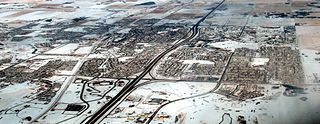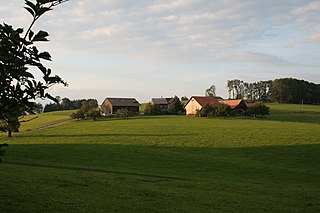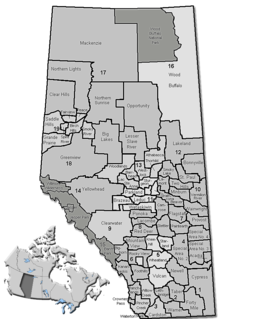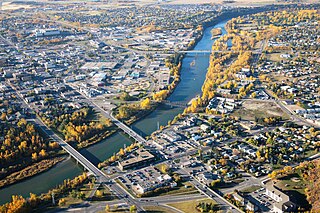| ||
 Distribution of Alberta's 269 urban municipalities | ||
Alberta has provincial legislation allowing its municipalities to conduct municipal censuses between April 1 and June 30 inclusive. [1] [2] Municipalities choose to conduct their own censuses for multiple reasons such as: to better inform municipal service planning and provision; to capitalize on per capita based grant funding from higher levels of government; or to simply update their populations since the last federal census. [3]

Alberta is a western province of Canada. With an estimated population of 4,067,175 as of 2016 census, it is Canada's fourth most populous province and the most populous of Canada's three prairie provinces. Its area is about 660,000 square kilometres (250,000 sq mi). Alberta and its neighbour Saskatchewan were districts of the Northwest Territories until they were established as provinces on September 1, 1905. The premier has been Rachel Notley since May 2015.
Four provinces and territories in Canada have legislation that allow municipalities to conduct a municipal census. These include the provinces of Alberta and Saskatchewan and the territories of Nunavut and Yukon. Of these four provinces and territories, municipalities in Alberta were the only ones that exercise the option to conduct a municipal census as of 2006.

A census is the procedure of systematically acquiring and recording information about the members of a given population. The term is used mostly in connection with national population and housing censuses; other common censuses include agriculture, business, and traffic censuses. The United Nations defines the essential features of population and housing censuses as "individual enumeration, universality within a defined territory, simultaneity and defined periodicity", and recommends that population censuses be taken at least every 10 years. United Nations recommendations also cover census topics to be collected, official definitions, classifications and other useful information to co-ordinate international practice.
Contents
- Municipal census results
- Breakdowns
- Hamlets
- Shadow population counts
- Notes
- See also
- References
- External links
Alberta had 357 municipalities between April 1 and June 30, 2014, down from 358 as at June 30, 2013, [lower-alpha 1] which marked the closure of the 2014 legislated municipal census period. At least 39 of these municipalities (10.9%) conducted a municipal census in 2014. Alberta Municipal Affairs recognized those conducted by 37 of these municipalities. [5] By municipal status, it recognized those conducted by 13 of Alberta's 17 cities, 18 of 108 towns, 3 of 93 villages, 1 of 51 summer villages and 2 of 64 municipal districts. [5] [lower-alpha 2] In addition to those recognized by Municipal Affairs, censuses were conducted by the Town of Drayton Valley and the Municipal District of Lesser Slave River No. 124. [6] [7]

Events from the year 2014 in Canada.
Alberta Municipal Affairs is a ministry of the Executive Council of Alberta. Its major responsibilities include assisting municipalities in the provision of local government, administering the assessment of linear property in Alberta, administering a safety system for the construction and maintenance of buildings and equipment, and managing Alberta's network of municipal and library system boards.

Drayton Valley is a town in central Alberta, Canada. It is located on Highway 22, approximately 133 kilometres (83 mi) southwest of Edmonton. It is surrounded by Brazeau County, known for its vast oil fields. The town is located between the North Saskatchewan River and the Pembina River.
Some municipalities achieved population milestones as a result of their 2014 censuses. Airdrie and Cochrane grew beyond the 50,000 and 20,000 marks respectively, while both Beaumont and Cold Lake exceeded 15,000. The towns of Morinville, St. Paul and Raymond surpassed 9,000, 6,000 and 4,000 residents respectively, while the Municipal District (MD) of Lesser Slave River No. 124 exceeded 3,000.

Airdrie is a city in Alberta, Canada within the Calgary Region. It is located north of Calgary within the Calgary–Edmonton Corridor at the intersection of Queen Elizabeth II Highway and Highway 567.

Cochrane is a town in the Canadian province of Alberta. The town is located 18 km (11 mi) west of the Calgary city limits along Highway 1A. With a population of 26,320 in 2017, Cochrane is the second largest town in Alberta and one of the fastest growing communities in Canada. It is part of Calgary's census metropolitan area and a member community of the Calgary Regional Partnership (CRP). The town is surrounded by Rocky View County.

Beaumont is a city in Leduc County within the Edmonton Metropolitan Region of Alberta, Canada. It is located at the intersection of Highway 625 and Highway 814, adjacent to the City of Edmonton and 6.0 kilometres (3.7 mi) northeast of the City of Leduc. The Nisku Industrial Park and the Edmonton International Airport are located 4.0 kilometres (2.5 mi) to the west and 8.0 kilometres (5.0 mi) to the southwest respectively.







